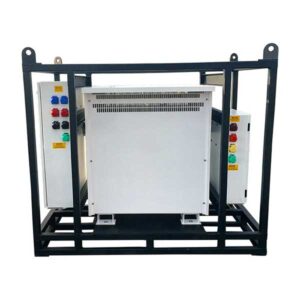Wherever a transformer is, it’s there for one specific job and that’s to convert your power source into the correct voltage and current to get the correct amount of power where you need it. (Read more about how an electrical transformer works.) Whether it’s a wellhead site, a neighborhood, a shipyard, or a large outdoor event, it’s important to know what type of transformer your application calls for.
Power Transformer vs Distribution Transformer
There are two main types of transformers that you can encounter when mapping out an electrical system. Here we will explain the difference between the two so you can understand what type of transformer you’ll need for your specific use.
Power Transformers
 The first type of transformer that most people will see are power transformers. You can see transformers like these when driving around a city or town and you pass by the local power plant. Power transformers are used to transfer electrical energy in any part of the electronic circuit between the generator and the distribution primary circuits. Power transformers are used for the transmission purpose at a heavy load with high voltage greater than 33 KV and 100% efficiency. This type of transformer is used in a transmission network, so they do not directly connect to the consumers. Load fluctuations are much less, and power transformers are also much bigger in size compared to distribution transformers.
The first type of transformer that most people will see are power transformers. You can see transformers like these when driving around a city or town and you pass by the local power plant. Power transformers are used to transfer electrical energy in any part of the electronic circuit between the generator and the distribution primary circuits. Power transformers are used for the transmission purpose at a heavy load with high voltage greater than 33 KV and 100% efficiency. This type of transformer is used in a transmission network, so they do not directly connect to the consumers. Load fluctuations are much less, and power transformers are also much bigger in size compared to distribution transformers.
Power transformers are used in distribution systems and most popular for utility power at power plants for power networks in cities and towns. Although these are common in cities, they can also be used to distribute and transform power on job sites built in desolate areas with their own generator acting as a power source in part due to being out of reach from the power grid.
Distribution Transformers
The second type of transformer you need to know about when dealing with power is a distribution transformer. They can be either ventilated or totally enclosed with either aluminum or copper windings in ratings from 50VA up to 750 kVA. These transformers are generally used for lighting, supply appliances, motorized machinery, and general electrical distribution systems. Distribution transformers are commonplace on smaller job sites where there are many load fluctuations.
Distribution transformers are used at the distribution level where voltages tend to be lower and the secondary voltage is almost always the voltage delivered to the end consumer. These transformers are used in less complex electrical systems. Distribution transformers can be found on temporary work sites, converting power from the on-site generators to a secondary voltage to power tools and lighting.
Knowing what type of transformer is best for your application is key and sometimes not as easy as it seems. To get help choosing the right and most efficient transformer for your project, contact the power distribution experts at Power Temp Systems for a consultation.
Contact Us
